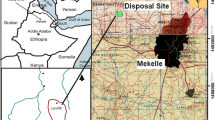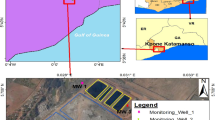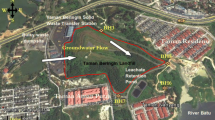Abstract
There is an urgent need for characterization of leachate arising from waste disposal to ensure a corresponding effective leachate management policy. Field and laboratory studies have been carried out to investigate the impact of municipal landfill leachate on the underlying groundwater at a site in West Malaysia. The solid waste was disposed of directly onto an unprotected natural soil formation. This situation was made worse by the shallow water table. The hydrochemical composition of groundwater in the vicinity of the site (background) is a dilute mixed cation, bicarbonate water. The high ionic balance error of ~13.5% reveals that the groundwater body underneath the site was a highly contaminated leachate rather than contaminated groundwater. Elevated concentration of chloride (355.48 mg/L), nitrate (10.40 mg/L as NO3), nitrite (14.59 mg/L), ammoniacal-N (11.61 mg/L), sodium (227.56 mg/L), iron (0.97 mg/L), and lead (0.32 mg/L) measured downgradient indicate that the contamination plume has migrated further away from the site. In most cases, the concentration of these contamination indicators, together with the ranges of sodium percentage (66.3–89.9%) and sodium adsorption ratio (10.1–19.7%), were found to be considerably higher than the limit values of safe water for both domestic and irrigation purposes, respectively.
Résumé
Les lixiviats issus du traitement des déchets doivent d’urgence être caractérisés pour permettre une politique appropriée de gestion de ces lixiviats. Des études de terrain et de laboratoire ont été conduites pour reconnaitre l’impact des lixiviats des décharges municipales sur les eaux souterraines sous-jacentes sur un site de Malaisie occidentale. Les déchets solides ont y été entreposés directement sur le sol naturel non protégé. La situation a été aggravée par le niveau peu profond de la nappe. La composition hydrochimique des eaux souterraines dans le voisinage du site (contexte) montre une eau bicarbonatée à divers cations. L’erreur forte ~13.5% sur la balance ionique révèle que la masse d’eau souterraine au droit du site était un lixiviat très contaminé plutôt que de l’eau souterraine contaminée. Les concentrations élevées en chlorures (355.48 mg/L), en nitrate (10.40 mg/L de NO3), en nitrite (14.59 mg/L), en azote ammoniacal (11.61 mg/L), en sodium (227.56 mg/L), en fer (0.97 mg/L), et en plomb (0.32 mg/L) mesurées à l’aval hydraulique indiquent que le plume de contamination a migré bien au-delà du site. Dans la plupart des cas, la concentration de ces indicateurs de contamination, de même que les intervalles de pourcentage de sodium (66.3–89.9%) et du ratio adsorption du sodium (10.1–19.7%), sont apparus très supérieurs aux valeurs limites pour les eaux respectivement à usage domestique et d’irrigation.
Resumen
Existe una necesidad urgente de caracterizar los lixiviados provenientes de la disposición de los residuos para asegurar una correspondiente política de manejo efectivo de los lixiviados. Se han llevado a cabo estudios de laboratorio y de campo para investigar el impacto del lixiviado de un relleno municipal sobre el agua subterránea subyacente en un sitio en Malasia occidental. El residuo sólido fue dispuesto directamente sobre una formación de suelo natural no protegido. Esta situación empeoró por el nivel freático somero. La composición hidroquímica de las aguas subterráneas (de fondo) en la vecindad del sitio es un agua diluida mixta bicarbonatada catiónica. El alto error del balance iónico de ~13.5% revela que el cuerpo de agua subterránea subyacente del sitio fue un lixiviado altamente contaminado más bien que un agua subterránea contaminada. Las elevadas concentraciones de cloruro (355.48 mg/L), nitrato (10.40 mg/L como NO3), nitrito (14.59 mg/L), N- amoniacal (11.61 mg/L), sodio (227.56 mg/L), hierro (0.97 mg/L), y plomo (0.32 mg/L) medidas gradiente abajo indican que la pluma de contaminación ha migrado más allá del sitio. En la mayoría de los casos se encontró que la concentración de estos indicadores de contaminación, conjuntamente con los intervalos del porcentaje de sodio (66.3–89.9%) y de la relación adsorción sodio (10.1–19.7%), eran considerablemente más altos que los valores límites de seguridad del agua para tanto propósitos domésticos como de irrigación.
摘要
目前急需对废物处置中产生的沥出液进行刻画的方法, 以制定有效的沥出液管理政策。本文对西马来西亚的一处场地开展了现场研究和实验室研究, 以调查城市垃圾填埋场沥出液对下伏地下水的影响。固体垃圾直接填埋于没有防护措施的天然土壤层之上。由于地下水位很浅, 情况变得更糟。场地附近地下水的水化学成分 (背景值) 是低浓度的混合阳离子, 重碳酸水。高达 ~13.5%的离子平衡误差表明, 填埋场下的地下水体与其说是受污染的地下水不如说是高度污染的沥滤液。在下游测量的氯化物 (355.48 mg/L), 硝酸盐 (10.40 mg/L, NO3), 亚硝酸盐 (14.59 mg/L), 氨氮 (11.61 mg/L), 钠 (227.56 mg/L), 铁 (0.97 mg/L) 和铅 (0.32 mg/L) 浓度增加, 表明污染晕已从填埋场运移到远处。多数情况下, 这些污染指示物的浓度, 连同钠百分比的范围 (66.3–89.9%) 和钠吸附比 (10.1–19.7%), 远高于生活和灌溉安全用水的极限值。
Resumo
Há uma urgente necessidade de caracterização dos lixiviados provenientes de lixeiras, a fim de assegurar uma efectiva política de gestão de lixiviados. Foram realizados estudos de campo e de laboratório para investigar o impacte dos lixiviados dos aterros municipais nas águas subterrâneas subjacentes, num local na Malásia Ocidental. Os resíduos sólidos foram depositados directamente sobre uma formação de solo natural não protegida, situação esta agravada pela presença de um nível freático pouco profundo. A composição hidroquímica de base da água subterrânea na vizinhança do local é bicarbonatada mista pouco mineralizada. O erro de balanço iónico elevado de ~13.5% revela que a massa de água subterrânea subjacente ao local é um lixiviado altamente contaminado, em vez de água subterrânea contaminada. As concentrações elevadas de cloreto (355.48 mg/L), nitrato (10.40 mg/L de NO3), nitrito (14.59 mg/L), azoto amoniacal (11.61 mg/L), sódio (227.56 mg/L), ferro (0.97 mg/L) e chumbo (0.32 mg/L) medidos a jusante do escoamento indicam que a pluma de contaminação já migrou para bastante longe do local do depósito de resíduos sólidos. Na maioria dos casos, a concentração destes indicadores de contaminação, em conjunto com os valores de percentagem de sódio (66.3–89.9%) e da taxa de adsorção em sódio (10.1–19.7%), revelou ser consideravelmente mais elevada que os valores limite de água segura, quer para uso doméstico, quer para rega.






Similar content being viewed by others
References
Abu-Rukah Y, Al-kofahi O (2001) The assessment of the effect of landfill leachate on groundwater quality: a case study—El-Akader landfill site, north Jordon. Arid Environ 49:615–630
Agamuthu P (2001a) Solid waste: principles and management, with Malaysian case studies. University of Malaya Press, Kuala Lumpur
Agamuthu P (2001b) Heavy metals contamination of soil-derived interstitial water in the coastal regions of Selangor Malaysia. Malays J Sci 20:127–134
Ahel M, Nevevka M, Bozena C, Prohic E, Vesna S (1998) The impact of contamination from municipal solid waste landfill (Zagreb, Croatia) on underlying soil. Water Sci Technol 37(8):203–210
Ahel M, Nevevka M, Bozena C, Prohic E (1999) Transport of contaminants from an unprotected landfill into adjacent groundwater aquifer. Proceedings of Sardinia 99, 7th Int. Waste Management and Landfill Symp., Cagliari, Italy, 4–8 October 1999
Alam Flora (2001) Landfill facts and figures. Document No. AFSB/SSA3 (Sepang)/6.2-L/.01/0294. Landfill Department, Alam Flora, Shah Alam, Malaysia
Al-Bassam AM, Al-Rumikhani YA (2003) Integrated hydrochemical method of water quality assessment for irrigation in arid areas: application to the Jilh aquifer, Saudi Arabia. J Afr Earth Sci 36:345–356
Al-Yaqout AF, Hamoda MF (2003) Evaluation of landfill leachate in arid climate: a case study. Environ Intl J 29:593–600
Atxotegi A, Iqbal MZ, Czarnetzki AC (2003) A preliminary assessment of nitrate degradation in simulated soil environments. Environ Geol 45(2):161–170
Ayers RS, Westcott DW (1994) Water quality for agriculture. FAO irrigation and drainage paper 29, FAO, Rome
Bahaa-eldin EAR, Yaacob WZW, Abdul Rahim S, Abdul Ghani MR (2003) Geo-environmental sampling: How good is a good practice? Bull Geol Soc Malays 46:443–446
Bahaa-eldin EAR, Yusoff I, Abdul Rahim S, Wan Zuhairi WY, Abdul Ghani MR (2008) Heavy metal contamination of soil beneath a waste disposal site at Dengkil, Selangor, Malaysia. Soil Sediment Contam 17(5):449–466
Bengtsson L, Bendz D, Hogland W, Rosqvist H, Aksson M (1994) Water balance for landfills of different ages. J Hydrol 158:203–217
Bernstone C, Dahil T (1997) Electromagnetic and DC resistivity mapping of waste deposits and industrial sites: experience from southern Sweden. Eur J Eng Environ Geophys 2:127–136
Christensen TH, Kjeldsen P, Bjerg PL, Jensen DL, Christensen BJ, Baun A, Albrechtsenv HJ, Heron G (2001) Biogeochemistry of landfill leachate plumes. Appl Geochem 16:659–718
Clement B (1995) Physicochemical characterization of 25 French landfill leachates. Proc. of Sardinia 95, vol 5, No. 1, The 5th Int. Waste Management and Landfill Symp., Cagliari, Italy, October 1995, pp 315–325
Clement B, Colin JR, Le Du-Delepierre A (1997) Estimation of hazard of landfills through toxicity testing of leachates. Chemosphere 35(11):2783–2796
Cronin C, Anita F (1998) Assessing groundwater analyses: some useful tips. GSI Groundwater Newslett 33:6–8
Del Borghi A, Binaghi LA, Converti A, Del Borghi M (2003) Combined treatment of leachate from sanitary landfill and municipal wastewater by activated sludge. Chem Biochem Eng Qual 17(4):277–283
Ding A, Zhang Z, Fu J, Cheng L (2001) Biological control of leachate from municipal landfills. Chemosphere 44(1):1–8
El-Fadel M, Bou-Zied E, Chahine W, Alayli B (2002) Temporal variation of leachate quality from pre-sorted and baled municipal solid waste with high organic and moisture content. Waste Manage 22:269–282
Fatta D, Voscos C, Haralambous AJ Loizidou M (1997) An assessment of the effect of landfill leachate on groundwater quality. Proc. of Sardinia 97, vol 6, No. 1, The 6th Int. Waste Management and Landfill Symp., Cagliari, Italy, October 1997,pp 181–187
Fetter CW (1988) Applied hydrogeology. Macmillan, New York
Flyhammar P (1997) Estimation of heavy metals transformation in municipal solid waste. Sci Total Environ 198:123–133
Frascari D, Bronzini F, Giordano G, Tedioli G, Nocentini M (2004) Long-term treatment and migration potential of landfill leachate: a case study in an active Italian landfill. Chemosphere 54(3):335–343
Hancock JS, Phillips IR, Seignor M (1995) Fate of contaminants deriving from municipal solid wastes in saturated landfills. Procs. of Sardinia 95, vol 5, No. 3, The 5th Int. Waste Management and Landfill Symp., Cagliari, Italy, October 1995, pp 611–620
Kelly WR, Wilson SD (2002) Temporal changes in shallow groundwater quality in northeastern Illinois. Proc. 12th Annual Illinois Groundwater Consortium (IGC) conference, April 2002. www.siu.edu/orda/igc/proceedings/02/kelly.pdf. Cited 17 November 2004
Kjeldsen P, Barlaz MA, Rooker AP, Baun A, Ledin A, Christensen T (2002) Present and long-term composition of MSW landfill leachate: a review. Crit Rev Environ Sci Technol 32(4):297–336
Malaysian Health Ministry (2000) National standard for drinking water quality. Quality Surveillance Unit, Engineering Services Division. Putrajaya, Malaysia
Matias MS, Marques MS, Ferreira P, Ramalho E (1994) A geophysical and hydrogeological study of aquifers contamination by a landfill. Appl Geophys 32(2–3):155–162
Meju MA (2000) Geoelectrical investigation of old/abandoned landfill sites in urban areas: model development with a genetic diagnosis approach. Appl Geophys 44:115–150
Mikac N, Cosovic B, Ahel M, Adreis S, Toncic Z (1998) Assessment of groundwater contamination in the vicinity of municipal solid waste landfill, Zagreb, Croatia. Water Sci Technol 37(8):37–44
Mohamed AF, Sarah AA, Mazlin M (2002) Issues in managing manufacturing industrial waste in Malaysia. Proc. of Environmental Management Int. Conf.: Ten Years After Rio. Bangi, Malaysia, pp 118–128
Noraini S (2003) Groundwater quality assessment using remote sensing and related database. Bull Geol Soc Malays 46:209–216
O’Leary P, Walsh P (1995) Decision maker’s guide to solid waste: waste management, vol II. Solid and Hazardous Waste Education Center, University of Wisconsin, Madison, WI
Onay TT, Pohland FG (1998) In situ nitrogen management in controlled bioreactor landfills. Water Res 32(5):1383–1392
Piper AM (1953) A graphic procedure in the geochemical interpretation of water analysis. Groundwater Note 12, US Geological Survey, Reston, VA
Sujatha D, Reddy BR (2003) Quality characterization of groundwater in the south-eastern part of the Ranga Reddy district, Andhra Pradesh. India Environ Geol 44:579–586
Tatsi AA, Zouboulis AI (2002) A field investigation of the quantity and quality of leachate from a municipal solid waste landfill in a Mediterranean climate (Thessaloniki, Greece). Adv Environ Res 6:207–219
Tatsi AA, Zouboulis AI, Matis KA, Samaras P (2003) Coagulation-flocculation of sanitary landfill leachates. Chemosphere 53:737–744
US Department of Energy (2004) Annual inspection report for the Weldon Spring Site, St. Charles, Missouri. Document No. S00790AE Weldon Spring Site LTS & M Plan, USDE, Washington, DC, pp 1–19
USEPA (Environmental Protection Agency) (2002) Implementation guidance for the arsenic rule. Document No. EPA-816-K-02-018, USEPA, Washington, DC
Wai L (1995) Locating US national standards for drinking water. J Gov Inf 22(2):101–117
WHO (1993) Guidelines for drinking water quality. World Health Organization, Geneva
Weng CN (2002) A critical review of Malaysia’s accomplishment on water resources management under agenda 21. Proceedings of International Conference on Environmental Management, Centre for Graduate Studies, National University of Malaysia (UKM), Bangi, Malaysia, pp 315–331
Acknowledgements
The authors wish to thank the Malaysian Ministry of Sciences, Technology and Environment for financial assistance under IRPA (RM8) grant 08-02-02-EA178. The authors are grateful to the research fellow at the Department of Geology, University of Malaya Emeritus, Professor Charles S. Hutchison for his critical and valuable review of this report.
Author information
Authors and Affiliations
Corresponding author
Rights and permissions
About this article
Cite this article
Rahim, Be.E.A., Yusoff, I., Samsudin, A.R. et al. Deterioration of groundwater quality in the vicinity of an active open-tipping site in West Malaysia. Hydrogeol J 18, 997–1006 (2010). https://doi.org/10.1007/s10040-009-0567-3
Received:
Accepted:
Published:
Issue Date:
DOI: https://doi.org/10.1007/s10040-009-0567-3




